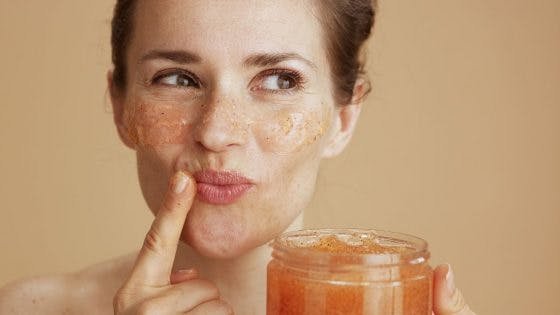How To Exfoliate Your Face Based On Your Skin Type

When it comes to face exfoliators, it can take effort to figure out which will suit your skin best. And it’s no wonder it can be overwhelming, as there are so many available – everything from gritty scrubs to liquid exfoliants on the shelves of our beauty stores. But if you want to work out how to find the best facial exfoliator, look no further. We spoke to some experts to get their advice on where to start.
Best facial exfoliators
Clarins Beauty Flash Peel is a powerful concoction that melt away the bonds that hold dead skin cells together. Containing AHA and BHA exfoliants, you can simply leave the product on the skin for 10 minutes before wiping it off to reveal ultimate radiance.
Clarins Fresh Scrub has a cream-gel texture, which is essential for anyone with dry, lacklustre skin. Containing a combination of larger and finer exfoliating beads, it’ll buff away the top layer of skin that causes dryness and dullness.
This One-step Gentle Exfoliating Cleanser combines orange extract, moringa seed extract, and silica microbeads to cleanse, exfoliate, and purify the skin. This multitasking exfoliating face wash formula leaves the skin refreshed, smooth, and radiant.
Clarins Comfort Scrub is enriched with sugar microcrystals, shea butter, and moringa extract, this top-rated face exfoliator for sensitive skin gently exfoliates, nourishes, and soothes the skin, leaving it soft, radiant, and comfortable.
Clarins
The Pure Scrub is a exfoliating cream for face that infused with natural microbeads, tamarind pulp acids, and shea butter. This refreshing scrub gently exfoliates and purifies, leaving the skin smooth, radiant, and refined.
What is the best face exfoliator for each skin type?
According to Spirithoula Koukoufikis, Senior Medical Aesthetician at
Looking for the best facial scrub for mature skin, you can try Clarins Beauty Flash Peel as a spa-inspired face exfoliator, gentle and no-rinse formula.
Difference between face exfoliator and face scrub
There are two different types of face exfoliators – chemical and physical. “Chemical exfoliation refers to when chemicals are used to exfoliate the top layer of the skin to remove the dead cells that sit on the skin’s surface,” says Dalya Sager, Global Trainer at Skinfluencer. “Water-soluble alpha-hydroxy acids (AHAs) produce a peeling action, which helps fade pigmented spots and even rough or bumpy patches. For more mature skin types, glycolic acid from the AHA family penetrates the deepest and can stimulate collagen production, improving skin texture and tone. Beta-hydroxy acids (BHAs) are oil-soluble and can clear excess debris and sebum,” she continues.
Regarding face scrubs, we refer to physical exfoliation methods such as salt or sugar scrubs. “Opt for a face scrub that contains micro exfoliants, which are small-size, non-coarse particles, that will not cause any trauma to the skin,” says Sager.
How to exfoliate your face
Wondering what’s the best way to exfoliate your face? Look no further…
● Step 1: Apply your chosen exfoliator to the face after cleansing.
● Step 2: Use circular motions to exfoliate the entire facial area, but avoid the eye contour area.
● Step 3: If a product sits on your face (such as a chemical peel), wait a few minutes before rinsing it off. If it’s a face scrub, lightly rinse your face with lukewarm water.
● Step 4: Pat the face dry and apply hyaluronic acid followed by a moisturiser.
How often should you exfoliate your face?
According to Dr Maryam Zamani, less is more when it comes to facial exfoliation. “Exfoliate gently in the evening 2-3 times a week. If your skin has become sensitive, listen to it, and ease up on actives for a while until it has fully recovered,” she explains.
When to exfoliate face
Remember to exfoliate your skin at night only. As the process of exfoliating might help your young skin cells come to your surface, exfoliating in the morning might make your skin become sensitive to external environment.
Thus, you should also use SPF in the next day when going out.
